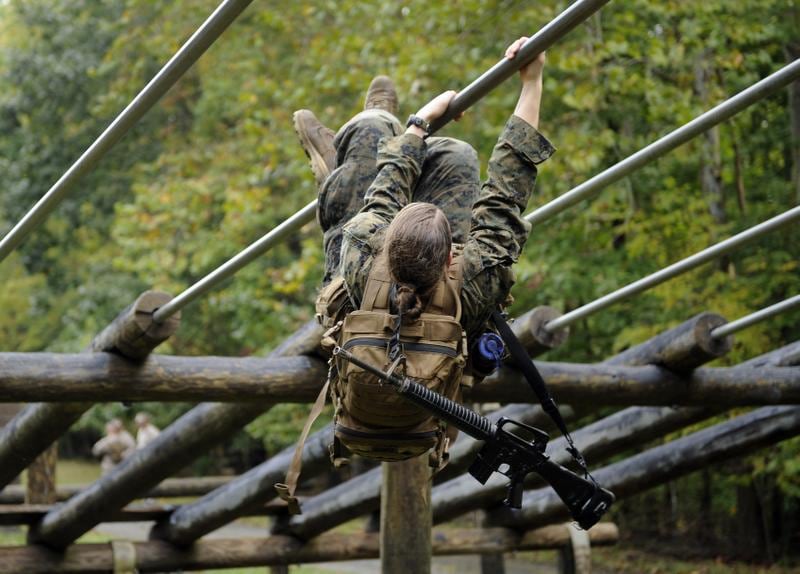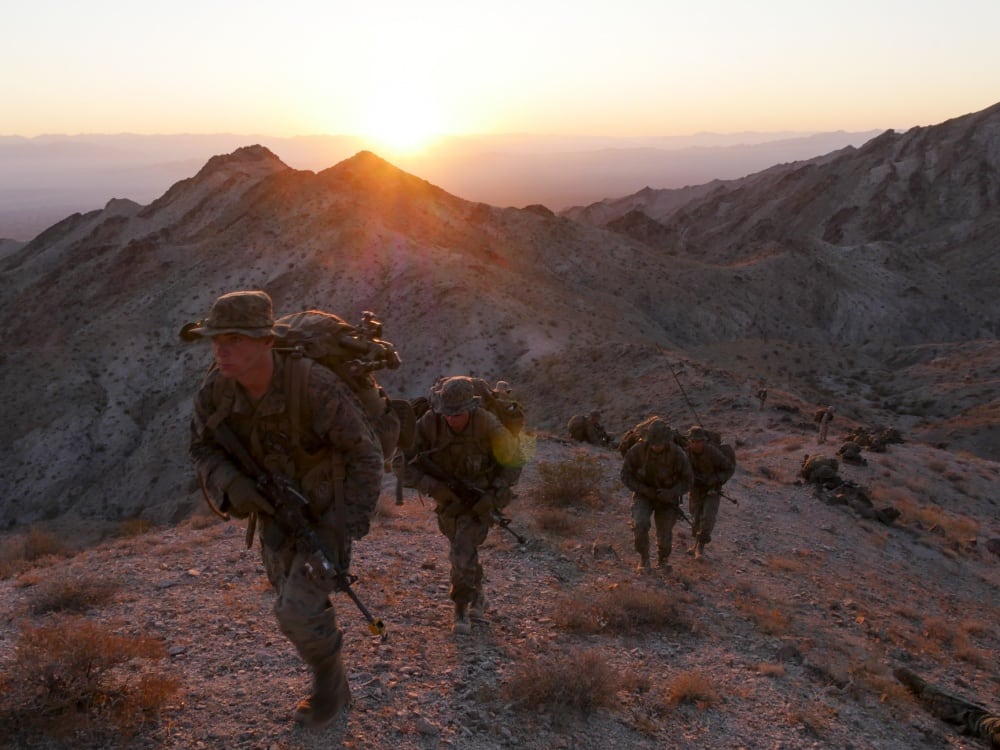Faced with towering attrition rates, the Marine Corps has steadily modified its grueling Infantry Officer Course ― changes that top Marines say are not attempts to water down standards, but to more accurately replicate today’s real-world requirements.
Recent changes include the number of evaluated hikes required to pass the course, and the removal of the physically demanding Combat Endurance Test as a strict requirement to graduate.
Under the new requirements, only three of those nine hikes will be evaluated, and Marines will have to pass all three evaluated hikes in order to graduate.
The condition that Marines at IOC participate in nine hikes remains unchanged.
Under the previous rules six of those hikes were evaluated, and Marines had to pass five of those six evaluated hikes.
The Corps in recent years has struggled to meet its goals in graduating an adequate number of new infantry officers. Attrition rates reached as high as 25 percent in 2014. But since implementing the new modifications, last year the Corps hit its target for the first time since 2008, Brig. Gen. Jason Q. Bohm, the commanding officer of Marine Corps Training Command, told reporters at a roundtable discussion Friday.
The Corps argues the changes made to the hikes more accurately reflect standards outlined in the Marine Corps infantry training and readiness manual ― standards that undergo a formal evaluation every three years.
The recent increase in graduation rate is also attributable to a newly added IOC preliminary course at The Basic School that helps better prepare future infantry leaders for the physically and mentally demanding challenges at IOC. That course starts two months before newly commissioned officers graduate from The Basic School. Marine officials contend The new course has been successful in reducing injuries at IOC.

Attrition rates under 10 percent are considered acceptable, but Bohm said he would like to see those numbers at 5 percent or below.
“That was a principal driver behind us making modifications to the course,” Bohm said. But, he argues, “it was not about lowering attrition, it was about making students more successful to complete the course.”
The Corps has come under criticism regarding the notoriously grueling 13-week infantry course that so far has only seen one woman successfully graduate.
But most washouts from the IOC are men — only 35 women have attempted the course, and only five of those have attended the IOC after the job field was opened to women.
RELATED

The recent changes, the Corps argues, have nothing to do with gender integration in the combat arms job fields or a watering down of any standards.
“Technically what we have done is we have modified graduation requirements, but we actually tie our requirements now more to the T&R [Marine infantry training and readiness manual] standards.”
While the Corps has modified graduation requirements to accurately reflect the infantry manual, Marines attending the course will still have to participate in all the events.
One of the evaluated hikes was changed to meet gender-neutral standards referred to as Military Occupational Specialty Specific Performance Standards, or MSPS, Bohm said.
The 2015 NDAA called for the service branches to draft gender-neutral standards as the services began gender integration into the combat jobs previously closed to women.
That hike that was changed is the 15-km hike, which must be completed within three hours while humping 105 lbs of kit and weapons.
The other two hikes evaluated for graduation purposes are a 7-mile hike carrying 95 lbs and a 9-mile hike carrying 105 lbs.

The hikes are “progressive in both distance and weight,” Bohm said.
But the Corps has struggled to adequately explain how its changes to the IOC are not an attempt to make the course easier, especially if one of the intended goals is to increase graduation numbers.
The Corps temporarily increased infantry course standards in 2012 when it made made passing the CET a graduation requirement.
That change was made to reflect an operational shift to a more physically demanding operating environment, according to Bohm. The CET was first introduced in 1994, but was only a graduation requirement from 2012 to November 2017.
In 2012 the Corps was changing how its forces operated on the ground. In Iraq, Marines were primarily vehicle mounted, but in Afghanistan “they were now fighting in mountainous terrain, foot mobile, carrying loads in austere conditions. So that started to modify the physical expectations of what we required,” Bohm said.
The Corps has since made gradual modifications over the past two years to help boost graduation rates.
While far fewer Marines are deployed to Afghanistan, the Corps is now prepping for a major confrontation with more capable adversaries like Russia and North Korea, where the climate and terrain may be more physically taxing than anything Marines have fought in since the Korean War.
“The course is as hard as it’s ever been. We did not do away with any training events,” Bohm said.
But, the Corps did make a major modification to one of its most grueling hikes known as the weapons company and weapons platoon hike. Previously, Marines had to conduct a single file forced march carrying heavy and medium weapon systems that could weigh anywhere from 125 lbs-150 lbs.
“There was a lot of angst about our students having to carry 150 lbs,” Bohm said.
Now the hike is done as a tactical displacement, where Marines practice bounding during a simulated attack. The Marines are no longer required to single-handedly carry all 125-150 lbs, and can pass the weight off to a buddy as they tire.
Bohm argues that this modification better reflects operational reality.
Marines spread load heavy weapon systems during marches, no single Marine ever carries the weight of the heavy weapon systems themselves. That weight is passed throughout the platoon or company throughout the hike.
To now graduate from IOC, Marine officers will need to:
- Participate in a total of nine hikes.
- Pass three evaluated hikes.
- Conduct the Combat Endurance Test (although passing it is no longer a requirement).
- Participate in six tactical field exercises.
- Pass infantry officer physical standards requirements, including a 15 km hike with 105 lbs in 3 hours.
- Cross a 56” wall unassisted in 30 seconds.
- Conduct a ground casualty evacuation (214 lbs. dummy) in 54 seconds.
- Lift a MK-19 heavy machine gun (77 lbs.) overhead, and rush 300 meters to an objective in 3 minutes 56 seconds.
Shawn Snow is the senior reporter for Marine Corps Times and a Marine Corps veteran.





